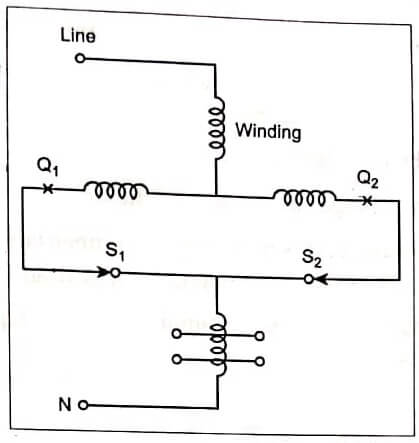Tap Changing Transformer
All power Tap changing transformer on transmission lines are provided with taps for control of secondary voltage. The tap changing transformers do not control voltage by regulating the flow of reactive VARs but by changing transformation ratio.
There are two types of tap changing transformers.
(a) Off-load tap changing transformers.
(b) On-load (under-load) tap changing transformers (OLTC).
The off-load tap changing transformer as shown in Fig which requires the disconnection of the transformer when the tap setting is to be changed. Off-load tap changers are used when it is to be operated in frequently due to load growth or some seasonal change.
On-Load Tap Changing Transformer (OLTC) is used when changes in transformer ratio to be needed frequently, and no need to switch off the transformer to change the tap of transformer. It is used on power transformers, auto transformers and bulk distribution transformers and at other points of load service.
The modern practice is to use on-load tap changing transformer which is shown in Fig. In the position shown, the voltage is maximum and since the currents divide equally and flow in opposition through the coil between Q1 and Q2, the resultant flux is zero and hence minimum impedance.
To reduce the voltage, the following operations are required in sequence
- Open Q1
- Move selector switch S1 to the next contact.
- Close Q1
- Open Q2
- Move selector switch S2 to the next contact.
- Close Q2
Thus, six operations are required for one change in tap position. The voltage change between tans is often 1.25 percent of the nominal voltage.
Applications of Tap changing Transformers
- Transformer with tap-changing facility constitute an important means of controlling voltage throughout the system at all voltage levels.
- Autotransformers used to change voltage from one sub-system to another are often furnished with under-load or on-load tap-changing facilities (ULTC). They may be controlled either automatically or manually. These are usually present throughout the network interconnecting transmission systems of different levels. The taps on these transformer provide a convenient means of controlling reactive power flow between subsystems. This in turn can be used to control line voltage profiles and reactive power losses.
- The control of single transformer will cause change in voltages at its terminals. In addition, it influences the reactive power flow through the transformer. During high system load conditions, the network voltages are kept at the highest practical level to maximize reactive power requirements and increase the effectiveness of shunt capacitors and line- charging.
- During lightly loaded condition, it is usually required to lower the network voltage, to reduce line charging and avoid under excited operation of generators.
- Transformers with off-load tap-changing facilities can also help to maintain satisfactory voltage profiles, while transformers with ULTC can be used to take care of daily, hourly and minute-by-minute variation in system conditions, setting of off-load tap changing transformers have to be carefully chosen depending on long term variation due to system expansion, load growth or seasonal changes.







